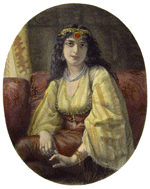
Herbert K. Bourne
British Portrait Engraver – 1825-1907
Hand-colored prints

A hand-colored print of an engraving by Bourne titled The Village Choir after an 1847 painting of the same name by Thomas Webster.
I remember watching my grandmother paint black-and-white studio photographs in the mid-1950s. Color photography had been available for over a decade by that time, but many of the studio's clients apparently preferred the softness of the skin tones and backgrounds that could be achieved with cotton swabs and fine brushes.
Hand-tinting had been used since the invention of monochrome photography, but seems to have been especially popular between 1900 and 1940. The most popular subjects seem to have included children and happy newlyweds.
Hand-coloring of monochrome engravings and lithographs probably dates from the very earliest period of invention, but became increasingly popular on a commercial basis in the late 1700s. This was especially true of aviary and botanical catalogs destined for university libraries. Early illustrations were typically made with woodcut technology. Better quality prints were made by printing from engraved and etched copper plates.
The success of illustrated newspapers like Harper's Weekly and Frank Leslie's Illustrated Newspaper proved there was a great hunger for illustrated periodicals among the general public. Unfortunately, woodcuts were expensive to produce and soft copper printing plates wore out quickly.
Along came Jacob Perkins in 1892, an American banknote printer. Perkins invented a way to engrave in soft steel and then harden that steel with heat. By the 1840s, American and European engravers had advanced the technique to a high degree of sophistication. Many American banknotes from that period show incredibly detailed vignettes.
Steel-plate engraving technology allowed much larger print runs than copper plates. In response, numerous magazines sprung to life, finally able to offer high-quality illustrations at prices middle-class Americans could afford. Magazines like Godey's Lady's Book (1830), Graham's Magazine (1841) and Union Magazine of Literature and Art (1847) all featured steel plate prints among their pages.
At the same time, numerous magazines embraced the technology, both in England and in continental Europe. One such magazine was the Art-Journal (1849) that gave Bourne substantial work.
Most of those magazines printed their steel plate illustrations on high-quality rag paper. While the magazines are difficult to find in intact form, large numbers of their engravings are still circulating among collectors.
Among those engravings are numerous hand-colored examples.

A hand-colored print of an engraving by Bourne titled The Village Choir after an 1847 painting of the same name by Thomas Webster.
One cannot question the age of the engravings themselves. Simply pass your finger very lightly across the surface and you will feel the raised ink. That kind of printing is called intaglio (pronounced in-TAL-ee-oh) printing. Contrast that with common lithograph printing which is entirely smooth to the touch. Once you come to appreciate intaglio printing, you will appreciate the phenomenal skill needed both to engrave the plates and print from them. The paper can be faked today, but not the intaglio printing.
There is a natural question about the hand-coloring, however. Were engravings colored in the 1800s? Or within a year or two of the flash fad of adult coloring books in 2015?
Maybe a professional colored pencil historian can tell the age differences, but I certainly can't. And you can be sure that no eBay seller can either.
However, that is really not the most crucial question. The question is, do hand-colored prints have any verifiable value?
So far, I have recorded only three sales from over 200 offerings of hand-colored prints. One sold at an abnormally high price, one at a very low price and and one was about average. One sale followed the coloring book fad and two preceded it. If there is a pattern among the three colored engravings that actually sold, I don't see it.
Overall, however, I can say that advanced collectors would never consider buying an engraved print that had been colored. I have been involved with collectors and collecting for 55 years. I have never encountered a serious collector who would buy a purposely altered collectible of any sort unless it was extremely valuable and otherwise unattainable in any other state.
A few Bourne prints are rare, especially the large Doré prints. The remainder are not particularly valuable. PLEASE, do not destroy a perfectly good engraved print in hopes of coloring it to make a profit. You will fail.